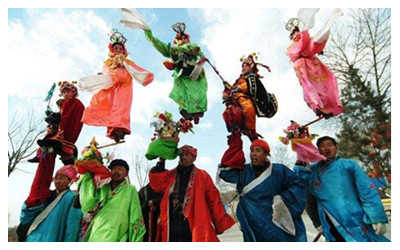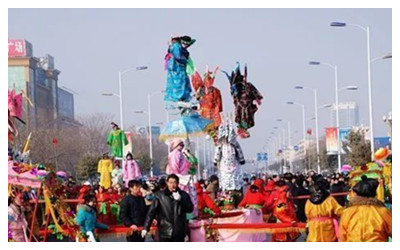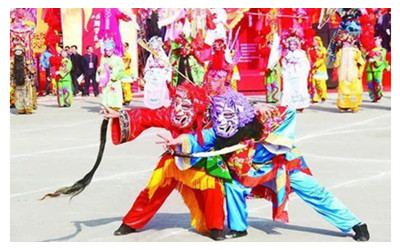- Home
- China Provinces Guide > Shanxi > Shanxi Travel Guide >
Shehuo Festival in Shanxi

Practiced during the Spring Festival, the Chinese lunar New Year, Shehuo is a spontaneous traditional festive occasion for songs and dances prevailing mainly in the countryside of North China. With a long history, these festive affairs are rooted in primitive sacrificial activities in which ancient people prayed for harvest and affluence with their songs and dances from "She," originally meaning the God of Earth, and "Huo," literally meaning fire which ancient people believed to have the magic power of driving away evil spirits.
Ⅰ. History Scattered historical records demonstrate the existence of Shehuo in the Spring and Autumn Period (770-476BC), the Warring States Period (475-221BC) and the Song Dynasty (960-1279). By the late Qing Dynasty (1644-1911), Shehuo in some places had been incorporated with the Temple Fairs.
But the reasons why Shehuo has survived and developed throughout Chinese history is not only limited to the sacrificial purposes. Shehuo is also a mass entertainment that involves a great deal of performers, virtually enabling almost all the villagers to participate either in the performance or the preparation work. Besides, it is also the natural outpouring of enthusiasm and love for life as well as a demonstration of talent and vitality.

Ⅱ. Genres There are many kinds of performances in the Shehuo activity. The main kinds include Xinzi (standing on a wick), carrying desks, stilts, bamboo horses, a lion dance and the land boat. Among them Xinzi and stilts are the most popular.
Xinzi is more like acrobatics. Little girls and boys in traditional costumes may stand on the edge of a "sword," "flower," "tree branch," or even "corn leaves." Some even use "spears" stabbing into the abdomen of the performer. In ancient times, four, eight or even a dozen people would lift up the desks that carried the children.
While the audience worries about the dangerous gestures and positions of the little girls and boys, the young performers seem very relaxed and carefree. The secret lies in the various shapes of hidden "wick" made of steel, which are used to fix the performers. Adult men, who are usually dressed up as traditional play figures, perform stilts. They usually use the "willow wood legs" longer than five feet, making their performance very thrilling and exciting. What's more amazing is the popular stilt dance.
Shehuo, originally a ceremony to honor gods and spirits from heaven and earth, gradually developed to a festive occasion to celebrate and pray for harvest in its long evolutionary process.
Ⅲ. Masks
The facial make-up used in Shehuo is a precious art form, demonstrating the unique artistic glamour of West China.

The facial make-up originated from primitive tattoo traditions. The tradition developed into face painting during the
Xia and
Shang dynasties (About 2,100-1,100BC) with the same purpose of driving away the demons. People at the time believed that the wizards with painted faces were endowed with the magic power to talk to God.
Multi-layer patterns and the unique West Chinese features of using bright colors usually characterized the facial make-ups in Shehuo. The steady style, uncouth sculpture, intense colors and simple yet delicate paintings, and bold, pure, fresh, free and exaggerated style can be found from all the original works, demonstrating the rich imagination and wisdom of the people. The works are mostly paintings of righteous figures that are said to have magic powers in folktales or legends. Besides its original purpose of warding off evil, the artwork also holds high aesthetic value.
Ⅳ. West Chamber Shehuo
Baoji in Shaanxi Province, which is generally known as West Chamber, boasts one of the most representative Shehuo art forms in
China. The Shehuo facial make-up in Baoji and Longxian counties are specially known for their fancy molds, bright colors and varied patterns, representing the highest level in the region.
With a wide variety of Shehuo genres prevailing in the region, the most special kind is the Blood Shehuo in Chisha Village of Baoji County, which is also the only existence of its kind all over the country and is only performed in leap years. The performance mainly features the revenge theme from classic stories like Outlaws of the Marsh.
The stunt skills of the Blood Shehuo still remain unknown to outsiders. It is said that the skill is only passed on to sons but not daughters.
 Practiced during the Spring Festival, the Chinese lunar New Year, Shehuo is a spontaneous traditional festive occasion for songs and dances prevailing mainly in the countryside of North China. With a long history, these festive affairs are rooted in primitive sacrificial activities in which ancient people prayed for harvest and affluence with their songs and dances from "She," originally meaning the God of Earth, and "Huo," literally meaning fire which ancient people believed to have the magic power of driving away evil spirits.
Practiced during the Spring Festival, the Chinese lunar New Year, Shehuo is a spontaneous traditional festive occasion for songs and dances prevailing mainly in the countryside of North China. With a long history, these festive affairs are rooted in primitive sacrificial activities in which ancient people prayed for harvest and affluence with their songs and dances from "She," originally meaning the God of Earth, and "Huo," literally meaning fire which ancient people believed to have the magic power of driving away evil spirits. Ⅱ. Genres There are many kinds of performances in the Shehuo activity. The main kinds include Xinzi (standing on a wick), carrying desks, stilts, bamboo horses, a lion dance and the land boat. Among them Xinzi and stilts are the most popular.
Ⅱ. Genres There are many kinds of performances in the Shehuo activity. The main kinds include Xinzi (standing on a wick), carrying desks, stilts, bamboo horses, a lion dance and the land boat. Among them Xinzi and stilts are the most popular. The facial make-up originated from primitive tattoo traditions. The tradition developed into face painting during the Xia and Shang dynasties (About 2,100-1,100BC) with the same purpose of driving away the demons. People at the time believed that the wizards with painted faces were endowed with the magic power to talk to God.
The facial make-up originated from primitive tattoo traditions. The tradition developed into face painting during the Xia and Shang dynasties (About 2,100-1,100BC) with the same purpose of driving away the demons. People at the time believed that the wizards with painted faces were endowed with the magic power to talk to God. Ask Questions ?
Ask Questions ?